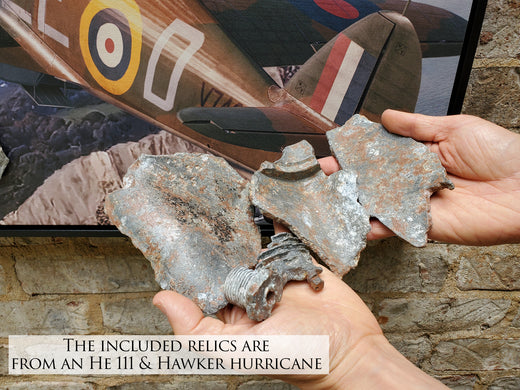This Fine Art Print by Artist Craig Tinder pays homage to famed RAF officer and Hawker Hurricane pilot, Douglas Bader. This print includes a one-of-a-kind and very RARE Hawker Hurricane relic as well as his foe - a downed Heinkel He 111 bomber.
Details about the RELICS:
These Hurricane relics were recovered in the 1990s and originate from the aircraft of Flying Officer Billy Drake. Drake was on a combat air patrol on May 13, 1940, when his oxygen system failed, forcing him to return to base. During the flight, he spotted what he believed were unescorted Dornier Do 17 bombers, and after downing one, he was shot from behind by a Messerschmitt Bf 110. Severely wounded by shell splinters, Drake bailed out and was evacuated back to England.
His participation in the Battle of France earned him several victories, including a Messerschmitt Bf 109 and Heinkel He 111, before his injuries ended his campaign. Despite these setbacks, Drake returned to combat, ultimately scoring 20 confirmed victories during World War II, winning numerous accolades, and retiring as a Group Captain.
 Rolls-Royce Merlin engine fragments from Hawker Hurricane
Rolls-Royce Merlin engine fragments from Hawker Hurricane
This Heinkel He 111 bomber artifact was recovered in 2017 approximately 30 km south of Vinnytsia, Ukraine. Many wing fragments were recovered and it is speculated this aircraft may have served in a logistics role as no evidence of munitions has been recovered.
The Story Behind the Print:
After losing his legs in an aerobatic crash in 1931, Douglas Bader recovered to become a highly capable and admirable leader within the RAF. Participating in the Battle of France and the Battle of Britain, Douglas Bader would amass 20 aerial victories against the Luftwaffe before being shot down and captured over France.
 British Ace - Douglas Bader
British Ace - Douglas Bader
Douglas Bader was a legendary British fighter pilot and national hero who became a symbol of resilience and courage during World War II. After losing both legs in a flying accident in 1931, Bader was discharged from the RAF, but he fought his way back into service at the outbreak of the war. Flying with prosthetic legs, he became a flying ace during the Battle of Britain, credited with over 20 aerial victories.
Despite his disability, Bader became one of the RAF's most effective and fearless leaders. His aggressive tactics and leadership skills earned him command of a fighter squadron, and he quickly rose to the rank of Wing Commander. Known for his uncompromising attitude, he inspired fellow pilots and played a crucial role in defending Britain from German air assaults.
In 1941, Bader was shot down over France and captured by the Germans, spending the remainder of the war as a prisoner of war. His attempts to escape and defiance toward his captors made him a celebrated figure. After the war, Bader continued his legacy as an advocate for disabled veterans and was knighted in 1976 for his services to the disabled community. His life exemplifies determination, bravery, and overcoming adversity.
Learn more about A Combat Debut That Sculpted Aeronautical Warfare for Heinkel He 111 in the Spanish Civil War? Click Here
To purchase or see similar items, visit here.
Commissioned by Museums, Treasured by Collectors





Share:
Escorting History, the story behind "Dusk Patrol"
Stuka Assault, the story behind "Eagle of the Eastern Front"